In Advertisements, “ads,” are the strategic messages crafted by businesses to promote their products, services, or brand across various online platforms. These platforms include search engines, social media networks, websites, and mobile applications, among others. The primary goal of digital ads is to capture the attention of a target audience, drive engagement, and ultimately influence consumer behaviour.
The blog delves into a analysis between two prominent players in the digital advertising arena: Google Ads and Facebook Ads. The key components of digital ads, including attention-grabbing headlines, persuasive body copy, impactful visual elements, and decisive calls to action, are dissected in the context of these platforms. The foundation of how Facebook Ads and Google Ads operate is explored, with a keen focus on their respective strengths and optimal use cases.
- Reading Time: 5 mints

Key Components of Digital Ads:
The term “key components of ads” refers to the essential elements that constitute an advertisement. These components are crucial for shaping the overall message and effectiveness of the ad. The primary key components typically include:
Headline:
The headline is the attention-grabbing text at the top of the ad, designed to capture the viewer’s interest and encourage further reading.
Body Copy:
The body copy provides additional information about the product or service. It aims to persuade the audience by highlighting key benefits and features.
Visual Elements:
Visual components, such as images or videos, convey the brand message. Compelling visuals enhance the overall impact of the ad.
Call-to-Action (CTA):
The CTA prompts the viewer to take a specific action, such as purchasing, signing up for a newsletter, or visiting the website. It adds a sense of urgency or incentive.
The Foundation: How Facebook Ads Works
Ad Auction System: The Digital Marketplace
Facebook hosts an ad auction where advertisers bid for ad space based on predefined objectives, such as clicks, impressions, or conversions. This ensures fair competition and optimal ad delivery.
Targeting Precision: Tailoring Ads to Specific Audiences
Advertisers define their target audience using diverse criteria, including demographics, interests, and behaviors. Facebook’s robust targeting options enable advertisers to reach users with the highest likelihood of engaging with their content.
Ad Placement: Seamlessly Integrating into the User Experience
Facebook strategically places ads in users’ feeds, ensuring a seamless integration that feels native to the platform. Whether appearing in the news feed, stories, or the right column, ads align with the user experience.
Ad Formats: Diverse and Engaging Creative Options
Facebook offers a plethora of ad formats, from image and video ads to carousel and slideshow formats. Advertisers can choose the format that best showcases their brand, products, or services, enhancing engagement and interaction.

The Foundation: How Google Ads Works
Auction-Based System:
Google Ads operates on a sophisticated auction system where advertisers bid for the placement of their ads. The ad auction considers various factors, including bid amount, ad relevance, and expected click-through rate (CTR).
Keywords: The Heart of Ads:
Advertisers select relevant keywords that trigger the display of their ads when users search for those terms. This ensures that ads reach audiences actively interested in the products or services offered.
Ad Rank and Quality Score:
Advertisers’ positions in the ad auction are determined by the Ad Rank, a metric combining bid amount, ad relevance, and CTR. Quality Score, a crucial component of Ad Rank, assesses the quality and relevance of ads and landing pages.
Choosing between Google Ads and Facebook Ads depends on your business objectives, target audience, and budget. Google Ads is suitable for high-conversion goals, leveraging search intent, and reaching a vast online audience.
On the other hand, Facebook Ads excels in creative advertising, precise targeting, and lead generation.
The overarching goal is to wield influence over consumer behaviour, encouraging them to take desired actions, whether it be making a purchase, subscribing to a service, or exploring a brand further.

Misbah Abdul-Jabbar
She has been the lead content writer at Rankiz since May 2022. Her passion for helping people through his words.
Final Thoughts:
Consider combining both platforms to create a comprehensive advertising strategy. Use Facebook Ads for brand awareness and capturing attention, while relying on Google Ads to target users in the later stages of the customer lifecycle when they’re ready to make a purchase. By understanding the strengths and weaknesses of each platform, you can optimize your advertising efforts and achieve greater success in the digital landscape.




